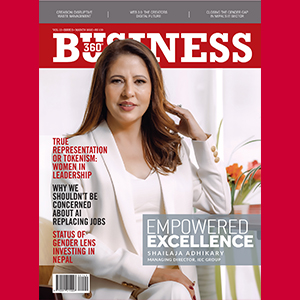
By Rebati Adhikari
Allopathic medicine is the first choice for most people. The thought of alternative treatment methods comes to mind only when hospitals/modern medical science fails to bring desired results. We switch to alternative medicine as a last resort after allopathic medicine proves ineffective. However, there are people whose first choice is alternative medicine.
Medical science has achieved a lot but it also has its limitations. Biomedicine which is believed to be based on research and science has gaps to be filled. This is where alternative medicine comes in use. Hospitals and health centers providing conventional modern medical services and complementary services are currently operating separately. What if they were to come together? Wouldn’t health care be much more productive? Is the integration of modern science and alternative medical science a possibility?
Rashila Deshmaru, a resident of Bhaktapur suffered from leg paralysis two years ago. She was under medication from a renowned hospital in Sinamangal for a month without much success. Eventually, the hospital advised her to try acupuncture. Within a week of treatment, she saw signs of improvement and in a month she was able to stand on her feet.
Originated from China, acupuncture treatment involves the use of needles exerting pressure on acupoints of the body. Legitimised by WHO, acupuncture is one of the most popular among complementary protocols. It is widely used to control pain. In ‘Acupuncture: review and analysis of reports on controlled clinical trials’ a report prepared by WHO, it is stated that success of pain relief by acupuncture ranges between 55–85%, whereas morphine helps in 70% of cases and far outweighs the placebo effect (30–35%).
“Nowhere has it been mentioned that those who intake allopathic medicine can’t use alternative medicine and vice versa. There comes a point during treatment where acupuncture has to be applied even though a patient is using mainstream medicine and vice versa. If both sciences are used together, the result is more impactful,” asserts acupuncture specialist Ishwor Balami. He opines, “No science is perfect. If it was, nobody would lose their lives. We should take them as complementary to each other.” He further states, “The way alternative medicine is defined here is wrong. If any patient uses allopathic medicine first, it is the first or mainstream medicine for them, and the other healing techniques are alternatives, and if a patient uses alternative healing techniques at first then it is the first medicine for them and allopathy becomes alternative”. In his practice, 50% patients come unsatisfied with allopathic medicine, 50% are those who believe in acupuncture treatment. “Acupuncture is a healing method better known for having no side effects,” Balami claims.
There is a gamut of alternative medicines like acupuncture, acupressure, homeopathy, ayurveda, reiki, Chinese medicine, yoga, naturopathy currently practiced in the country. Some of the recognised alternative treatment methods by the government of Nepal are ayurveda, homeopathy, naturopathy and acupuncture.
Dinesh Man Lakhe, acupressure specialist practices at Everest Natural Health Center. He says, “Allopathic treatment methods can be effective for some but for others it may be fruitless. Likewise, alternative treatment also don’t work for all. So I believe integration of both would be better in service delivery.” These days people directly come to us, while some are referred from mainstream hospitals,” he adds. Both systems have their own strengths and weaknesses. Alternative medicine is better in treating side effects of chronic diseases primarily handled by Western medicine. Acupuncture has proved helpful in relieving many side effects of cancer treatments and post operation pain. Lakhe claims, “acupressure healing method can provide relaxation, remove fatigue which modern medicine rarely does.”
Ayurveda doctor Asheem Baidya asserts, ‘Modern science has limitations but Ayurveda covers a wide range of areas. It is more productive in treating acute diseases like paralysis, constipation.” According to him, the acceptance rate of ayurveda stands at 20-30%. Baidya applies both allopathic medicine and ayurveda while treating patients and has seen positive results. He states that conventional doctors are also recommending these which certify that integration is a possibility. “In India these two types of treatment methods have been integrated and used; but, in Nepal, parallel use of them will take some time,” he shares.
Sujil Manandhar and his family take allopathic medicine only in cases of chronic diseases. As far as possible, Manadhar tries to keep his daughter away from allopathic medicine. “Once my daughter had a common cold and we started allopathic drugs but it didn’t work at all. However, ayurveda did it. You will not get a quick remedy but it’s better than allopathic medicine,” he shares. It should not be forgotten that earlier, before modern medicine found prominence, herbal medicine took care of our overall health.
The principle which conventional medicine and alternative medicine is based on is very different. Bala Rami Kisi, homeopathic doctor says, “There is no necessity to use them together. It is like pressing on brakes and accelerator at the same time. Allopathy works on suppressive principle while the latter works on curative principle. Moreover, homeopathy treats diseases from the root.” For diabetic and hypertension patients, we don’t let them discontinue allopathic drugs while carrying homeopathic treatment. But there should be a gap of half an hour in between taking the medicines. We slowly decrease the dose of allopathic drugs and supplement it with homeopathic medicine. Though there is no harm in using them together, it lengthens the curing process,” he adds. Homeopathy is based on the principle of treating ‘like with like’. WHO has referred it as the second largest medicine being used in the world.
Besides the effectiveness of alternate healing techniques, its affordability also outweighs allopathic medicine. “Allopathic may look inexpensive in the short term use but in the longer run it becomes costly. Ayurveda comes cheap when used for a long time,” shares Baidya.
Integration of both sciences could provide better results for a range of diseases.





